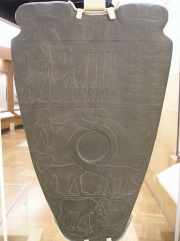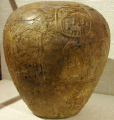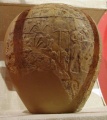Naqada III dell'Egitto
Da Ufopedia.
| Questa voce ha bisogno di essere tradotta. |

Naqada III is the last phase of the Naqadan period of ancient Egyptian prehistory, dating approximately from 3200 to 3000 BC.[1] It is the period during which the process of state formation, which had begun to take place in Naqada II, became highly visible, with named kings heading powerful polities. Naqada III is often referred to as Dynasty 0 or Protodynastic Period[2] to reflect the presence of kings at the head of influential states, although, in fact, the kings involved would not have been a part of a dynasty. They would more probably have been completely unrelated and very possibly in competition with each other. Kings names are inscribed in the form of serekhs on a variety of surfaces including pottery and tombs.
The Protodynastic Period in ancient Egypt was characterised by an ongoing process of political unification, culminating in the formation of a single state to begin the Early Dynastic Period. Furthermore, it is during this time that the Egyptian language was first recorded in hieroglyphs. There is also strong archaeological evidence of Egyptian settlements in southern Kanaan during the Protodynastic Period, which are regarded as colonies or trading entrepôts.
State formation began during this era and perhaps even earlier. Various small city-states arose along the Nile. Centuries of conquest then reduced Upper Egypt to three major states: Thinis, Naqada, and Nekhen. Sandwiched between Thinis and Nekhen, Naqada was the first to fall. Thinis then conquered Lower Egypt. Nekhen's relationship with Thinis is uncertain, but these two states may have merged peacefully, with the Thinite royal family ruling all of Egypt. The Thinite kings are buried at Abydos in the Umm el-Qa'ab cemetery.
Most Egyptologists consider Narmer to be the last king of this period (although some place him in the First Dynasty). He was preceded by the so-called "Scorpion King(s)", whose name may refer to, or be derived from, the goddess Serket, a special early protector of other deities and the rulers.
Wilkinson (1999) lists these early Kings as the un-named owner of Abydos tomb B1/2 whom some interpret as Iry-Hor, King A, King B, Scorpion and/or Crocodile, and Ka. Others favour a slightly different listing.
Naqada III extends all over Egypt and is characterized by some sensational firsts:
- The first hieroglyphs
- The first graphical narratives on palettes
- The first regular use of serekhs
- The first truly royal cemeteries
- Possibly, the first irrigation
Indice |
Galleria immagini
References
Books
- Anđelković, Branislav. 2002. "Southern Canaan as an Egyptian Protodynastic Colony." Cahiers Caribéens d’Égyptologie 3/4 (Dix ans de hiéroglyphes au campus):75–92.
- Bard, Katherine, A. 2000. "The Emergence of the Egyptian State." In The Oxford History of Ancient Egypt, edited by Ian Shaw. Oxford and New York: Oxford University Press. 61–88
- Midant-Reynes, Béatrix. 2000. The Prehistory of Egypt: From the First Egyptians to the First Pharaohs. Translated by Ian Shaw. Oxford and Malden: Blackwell Publishers
- Wilkinson, Toby Alexander Howard. 2001. Early Dynastic Egypt. 2nd ed. London: Routledge
- Wright, Mary. 1985. "Contacts Between Egypt and Syro-Palestine During the Protodynastic Period." Biblical Archeologist: Perspectives on the Ancient World from Mesopotamia to the Mediterranean 48 (4):240–253.











